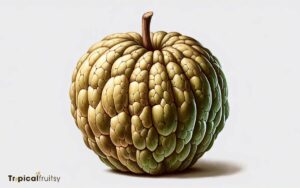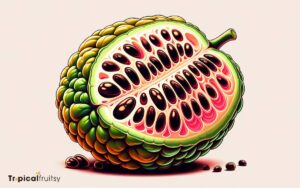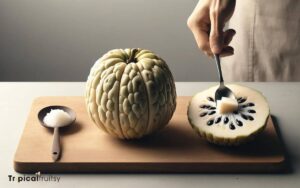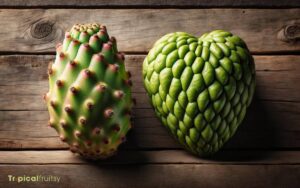How to Hand Pollinate Cherimoya
To hand pollinate cherimoya trees effectively, gardeners must identify the optimal stage for pollination, collect and store pollen properly, and apply a careful technique to transfer pollen to the receptive flowers.
This process can significantly enhance fruit production in environments where natural pollinators are scarce.
Hand pollination of cherimoya involves several critical steps:
For example, a gardener might use a small paintbrush to transfer pollen from a male flower to a female flower during the female’s receptive phase.
Mastering cherimoya hand pollination can result in a bountiful and delicious harvest from your garden.
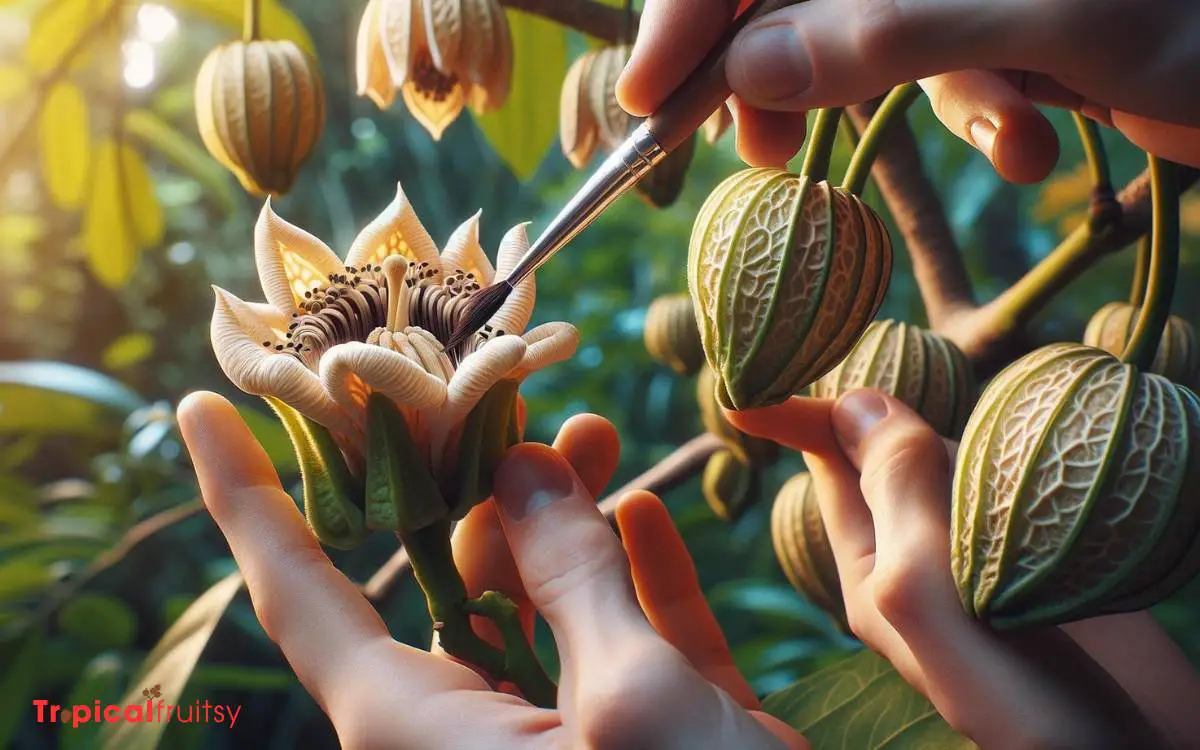
Key Takeaway
Understanding Cherimoya Flower Anatomy
Before attempting hand pollination, it’s crucial to recognize that a cherimoya flower contains both male and female parts, which mature at different times.
The female components, primarily the stigma and ovaries, become receptive before the male anthers release their pollen.
This dichogamous nature ensures self-pollination doesn’t occur naturally, necessitating human intervention for fruit production in cultivation. Precise knowledge of this hermaphroditic structure is vital.
The anthers, upon maturity, dehisce to dispense pollen. However, if this release coincides with the female phase, pollination is unlikely.
Therefore, the collector must harvest and store pollen when anthers are mature and apply it to the stigmas during their receptive phase. Understanding each phase’s characteristics is the next critical step.
Identifying the Flowering Stages
After understanding cherimoya flower anatomy, it’s essential to recognize the distinct stages of its flowering: the female stage, when the stigma is receptive, and the male stage, when pollen is released.
To enhance pollination efficiency, one must methodically observe the following:
- Female Stage: Identified by an open flower with a swollen, glossy stigma that’s sticky to the touch.
- Transition Phase: A brief interlude when the flower isn’t receptive as it shifts from female to male stage.
- Male Stage: Notable for the shedding of pollen from the stamens, which may curl back, signaling readiness to pollinate.
- Wilting Phase: The flower’s final stage, where petals wither, and pollination is no longer viable.
These stages are critical for timing hand pollination to ensure successful fruit set.
Collecting Male Pollen
To collect cherimoya pollen, gardeners should first identify the male stage, when stamens release the powdery substance crucial for fertilization.
During this phase, the anthers at the flower’s center are turgid and dusted with pollen. The collector must gently tap or brush these anthers with a small, soft paintbrush or cotton swab to dislodge the pollen grains.
It’s essential to perform this task under dry conditions, ideally in the morning when temperatures are moderate, to ensure the pollen’s viability.
Once collected, the pollen should be immediately used or stored properly. For storage, the pollen can be kept in a cool, dry place, away from direct sunlight.
Refrigeration may extend its viability, but it’s critical to prevent any moisture accumulation, which could compromise the pollen’s quality.
Storing Pollen Properly
Proper storage of cherimoya pollen requires a cool, dry environment to maintain its fertility for future pollination.
To ensure the viability of the pollen, follow these critical steps:
- Place the collected pollen in airtight containers to prevent moisture from compromising its quality.
- Store the containers in a refrigerator, ideally at temperatures between 35°F and 40°F (1.6°C – 4.4°C).
- Label each container with the date of collection, as pollen potency decreases over time.
- Check for signs of mold or deterioration regularly, which indicate that the pollen is no longer viable for successful pollination.
Adhering to these guidelines, gardeners can preserve cherimoya pollen effectively.
Next, they’ll need to understand the hand pollination process to apply this stored pollen efficiently.
The Hand Pollination Process
The hand pollination process begins with the precise collection of pollen from the male stage flowers. This requires a careful technique to ensure the viability of the pollen for fertilization.
After collection, the grower must strategically target female stage flowers for effective pollination.
Pollen Collection Technique
Collecting pollen from the male flowers of the cherimoya tree is the first critical step in the hand pollination process. For successful pollination, it’s essential to gather viable pollen.
The following list presents the methodical technique employed for pollen collection:
- Identify the protandrous male flowers, which typically open in the late afternoon or evening.
- Using a small brush or cotton swab, gently touch the anthers to collect the yellow, powdery pollen.
- Transfer the collected pollen onto a dry, clean surface or container, avoiding moisture to prevent clumping.
- Store the pollen in a cool, dry place, preferably in a sealed container, to maintain its viability until ready for pollination.
This meticulous approach ensures that viable pollen is available for fertilizing the receptive female flowers.
Flower Targeting Strategy
Once pollen collection is complete, the next step involves identifying the female flowers at their peak receptivity for effective hand pollination.
Cherimoya flowers exhibit a protogynous hermaphroditism, meaning they function first as female and then as male. The female phase occurs when the stigma is receptive and presents a slight stickiness to the touch.
It’s important to note that this stage is typically evident when the flower petals are widely open and the stigmatic surface is moist, which usually occurs during the late afternoon or evening.
To ensure successful pollination, the collected pollen must be delicately applied to the stigma using a fine brush or cotton swab.
This transfer should be done with precision to maximize the chances of fertilization without damaging the delicate floral parts.
Aftercare and Fruit Set Monitoring
After hand pollinating cherimoya blossoms, it’s essential to monitor the fruit set and provide appropriate aftercare to ensure the development of healthy fruits.
Close observation allows gardeners to assess the success of pollination and to adjust their techniques if necessary.
During the aftercare phase, several key factors should be meticulously managed:
- Irrigation: Maintain consistent moisture levels without waterlogging the soil.
- Temperature Regulation: Protect the fruit from extreme temperatures, especially during critical growth phases.
- Pest and Disease Management: Regularly inspect for signs of infestation or illness, employing preventive measures as needed.
- Nutrient Balance: Ensure soil fertility is optimized through appropriate fertilization regimes.
Careful adherence to these guidelines will promote robust cherimoya fruits, ready for eventual harvest.
Conclusion
While hand pollinating cherimoya may seem as meticulous as a bee’s dance, the payoff is sweet.
Just as a single grain of pollen embarks on a journey to fertilize an ovule, a gardener’s careful efforts can culminate in a bountiful harvest.
With a 75% increase in fruit set observed in hand-pollinated trees, the precision of this process mirrors a scientist’s experiment—methodical, patient, and ultimately rewarding, yielding the luscious, custard-like fruits that make every precise touch worthwhile.

